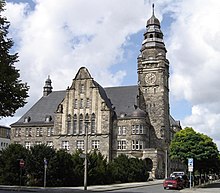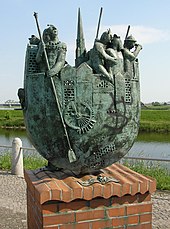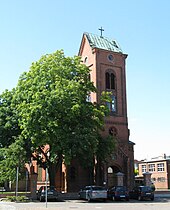Wittenberg
| coat of arms | Germany map | |
|---|---|---|
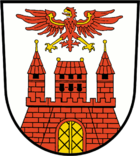
|
Coordinates: 53 ° 0 ' N , 11 ° 45' E |
|
| Basic data | ||
| State : | Brandenburg | |
| County : | Prignitz | |
| Height : | 22 m above sea level NHN | |
| Area : | 50.63 km 2 | |
| Residents: | 16,925 (Dec. 31, 2019) | |
| Population density : | 334 inhabitants per km 2 | |
| Postal code : | 19322 | |
| Area code : | 03877 | |
| License plate : | PR | |
| Community key : | 12 0 70 424 | |
| City structure: | 7 districts / boroughs | |
City administration address : |
August-Bebel-Strasse 10 19322 Wittenberge |
|
| Website : | ||
| Mayor : | Oliver Hermann (independent) | |
| Location of the city of Wittenberge in the Prignitz district | ||
Wittenberge is a city in the Prignitz district in northwest Brandenburg and the most populous place in Prignitz . The city on the Elbe , halfway between the metropolises of Berlin and Hamburg , has existed since the Middle Ages. It developed during industrialization through the Wittenberge train station and the Elbhafen as a technology location , especially with the railway repair and sewing machine factories. With the neighboring Perleberg it forms a middle center . The Elbland Festival takes place here every year .

geography
Wittenberge is located in the north-west of Brandenburg in the Prignitz , about eleven kilometers southwest of the district town of Perleberg , on the northern bank of the Elbe , directly at the confluence of the Stepenitz and the Karthane in this river . The city is roughly halfway between Berlin and Hamburg and Rostock and Magdeburg .
- Neighboring communities
Following clockwise are the neighboring communities, starting in the west, Cumlosen , Lanz , Perleberg , Weisen , Breese and Bad Wilsnack on the Brandenburg Elbe side and across the river Seehausen (Altmark) and Aland (Altmark) in Saxony-Anhalt .
City structure
According to the main statute of the city, the districts Bentwisch , Garsedow , Hinzdorf , Lindenberg , Lütjenheide , Schadebeuster and Zwischenendeich belong to Wittenberge . In addition, the three residential areas Berghöfe , Hermannshof and Wallhöfe are part of the urban area.
Lütjenheide, Schadebeuster and Zwischenendeich have been districts of Wittenberge since June 20, 1957. In 1962 Lindenberg was incorporated into Wittenberge and since 1995 it has been a district of Wittenberge. Garsedow and Hinzdorf were incorporated on October 20, 1971. Bentwisch joined on December 1, 1997.
history
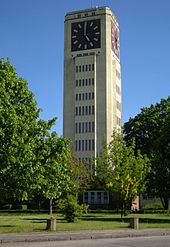
In the course of the German settlement after the conquest of the East Elbe territories, which later became the Mark Brandenburg, Wittenberge was founded under the care of the Gans family, as was Perleberg and Putlitz . Wittenberge is said to be in a document in 1226 that was only used as a transsumpt in an original document from Margrave Friedrich the Elder. J. von Brandenburg from February 15, 1463, was first mentioned in a document. In the said document, the Margraves Johann and Otto von Brandenburg decreed that no one was allowed to run a ferry on the Elbe between the town of Werben (Elbe) and “Wittemberge” . In 1910, Hermann Krabbo described the document from 1226 as a forgery, which was confirmed by research in the State Archives of Saxony-Anhalt in January 2006. Another documentary mention can be found on October 29, 1239. At that time, a witness signed a document with "prepositus de uittenberge". It was also Wittemberg documented on July 22, 1300 I as the city Mr. Otto Gans rights Wittenberges confirmed as a city.
At the end of the Thirty Years War Wittenberge was completely depopulated.
The city fell victim to devastating fires in 1686 and 1757 and the Elbe dike breaches in 1709 and 1761. In 1820 the first steamship on the Berlin-Hamburg passenger line docked in the port of Wittenberge. The city's industrial boom was achieved in 1823 by the construction of an oil mill (1823–1935: Herzsche Ölmühle , 1942–1946: Märkische Ölwerke Wittenberge AG , 1946–1990: VEB Märkische Ölwerke Wittenberge , 1990–1991: Märkische Ölwerke GmbH Wittenberge ) by the merchant Salomon Herz established. The completion of the Elbe port in 1835 and the connection to the Berlin-Hamburg railway line on October 15, 1846 as well as the completion of the connecting lines to Magdeburg between 1847 and October 25, 1851, Lüneburg (1874) and Salzwedel (1879) were also decisive for the economic development of the city. The oil mill was followed by a soap factory in 1846, a chemical factory in 1849 and a railway repair shop in 1875, which still exists today.
In 1903, the New York City- based Singer Manufacturing Company built a sewing machine factory, which continued to expand into the 1920s, including a. 1928/29 with the largest free-standing tower clock on the European continent . The Singer sewing machines were manufactured here until May 3, 1945 . Sewing machine production continued successfully during the GDR era. The sewing machines from Wittenberge were now called VERITAS and Naumann and became a world product. In the 1980s, the VEB sewing machine factory in Wittenberge advanced to become the most modern sewing machine factory in the world.
In 1912, the Gropius construction office was commissioned to take over the project and construction management of a large workers' estate in the north of the city. Around 1914, three types of settlement houses were built in this way, in which Gropius' concept of rationally constructed buildings could be implemented for the first time. The city of Wittenberge failed to place the buildings under monument protection, so that the original condition has been lost through decades of use and private renovations and additions.
As early as 1912, part of the cemetery was set up as a burial place for the city's Jews . The Jewish community founded in 1923, which did not have its own synagogue , buried its deceased members here. During the Nazi era in Germany, the National Socialists cleared the cemetery. Furthermore, founded in 1937 pulp and rayon factory which was located from 1942 on the site of concentration camp Wittenberge the Neuengamme concentration camp . The approximately 3,000 prisoners were obliged to do forced labor under inhumane conditions. Hundreds did not survive because they died of starvation, disease, or were murdered. In 1962 gravestones were restored and erected, as well as a memorial stone.
With the oil mill, Singer and the railway works as well as the construction of other factories such as the North German Machine Factory in 1935 and the cellulose and cellulose factory in 1937/38 , Wittenberge became the most important industrial city in the region. Due to the industrial and thus economic upswing, the population rose quickly. This led to the expansion of the urban area. Especially between the old town and the train station built around 1 km northeast of it, apartments for workers were built in several phases. These include a number of buildings from the Wilhelminian era that are gradually being renovated. The "House of the Four Seasons" with its facade in Art Nouveau deserves special attention .
In the years 1912–1914, the Wittenberg Town Hall (tower height 51 m) was built, which in its monumental design clearly symbolizes the urban aspirations of the up-and-coming industrial city. This awakening was dampened by the consequences of the First World War 1914–1918 and the global economic crisis from the end of the 1920s.
After 1816 Wittenberge belonged to the Westprignitz district in the Prussian province of Brandenburg ( administrative district Potsdam ). On August 1, 1922, the city of Wittenberge left the Westprignitz district and from then on formed its own urban district. In 1950 the city of Wittenberge lost its district freedom and was again incorporated into the Westprignitz district.
In 1952, the state of Brandenburg and the Westprignitz district were dissolved. From that time on, Wittenberge belonged to the Perleberg district in the Schwerin district , and since 1990 in Brandenburg . In 1993 the district of Perleberg and thus also Wittenberge became part of the newly formed district of Prignitz .
The reunification of Germany in 1990 brought considerable economic changes for the Prignitz and Wittenberge. In addition to the sewing machine factory (1991), the pulp factory (VEB Zellwolle, 1990) and the oil mill (1991) were also closed. Of the large companies, only the Reichsbahnausbesserungswerk Wittenberge (RAW) remained as the current maintenance facility of Deutsche Bahn AG . Due to the associated loss of jobs, there was a considerable emigration of residents (approx. 2% p. A. Since 1990), the end of which has not yet been forecast. The Wittenberge station, which until 2000 was still served every hour by ICE trains on the Hamburg – Berlin route, lost its importance dramatically.
Since the year 2000, the 700th anniversary of the city, Wittenberge has been the annual venue of the nationally known Elbland Festival Wittenberge (EFS), the international festival of operetta and cheerful stage arts in Germany. It is the most important music festival of this musical genre in Germany. Wittenberge is also the venue for the Paul Lincke International Singing Competition for Operetta .
Population development
|
|
|
|
|
1 In 1945 there were around 6,000 refugees in Wittenberge
Territory of the respective year
1991–2013, from 1991 as of December 31, from 2011 based on the 2011 census
politics
City Council
The city council of Wittenberge consists of 28 city councilors and the respective full-time mayor. The local elections on May 26, 2019 resulted in the following composition of the city council:
| Party / list | Seats |
| SPD | 8th |
| CDU | 7th |
| LEFT | 4th |
| AfD | 4th |
| FDP | 2 |
| GREEN | 2 |
| Single applicant Frank Fischer | 1 |
mayor
- 1990–1993: Sigmar Luft (CDU)
- 1993-2008: Klaus Petry (SPD)
- since 2008: Oliver Hermann (independent)
Hermann was confirmed as a candidate of the SPD on April 10, 2016 without an opponent with 94.8% of the valid votes for a further eight years.
flag
The city's flag is striped red and white (1: 1) and has the city's coat of arms in the center.
Town twinning
There are partnerships with the following cities:
Sights and culture
Buildings
- Steintorturm (oldest building, approx. 1300)
- Old Castle Wittenberge (Wittenberge City Museum)
- Evangelical church in the old town, built in 1872
- Neoclassical culture and festival hall
- Catholic Church of St. Heinrich, built in 1898, with a modern interior design (1976) by Friedrich Press
- Neo-Baroque town hall (1912-1914) (tower ascent possible in warmer seasons)
- Historic water tower in the city park (built in 1905) with pump room
- Art Nouveau house " House of the Four Seasons ", built in 1906, Schillerplatz
- Historic train station with a large Wilhelminian style dining room
- Old oil mill in Wittenberge built in 1856, the only brewery in Wittenberge and festival area of the Elbland Festival with "Elbland stage", capacity approx. 3500 visitors
- Former Singer / Veritas sewing machine works (built in 1903)
- Clock tower , largest free-standing clock tower on mainland Europe
- Gropiussiedlung in the north of the city
- Elbe bridge Wittenberge (road) (1978), with 1,110 m longest road bridge built in the GDR
- Elbe bridge Wittenberge (railway) (1987), with 1,030 m longest railway bridge built in the GDR
Sculptures and monuments
- The sculptor Christian Uhlig created the three-part sculpture group Zeitreise , which was placed on the banks of the Elbe.
- Memorial stone from 1949 opposite the main entrance of the cemetery at Parkstrasse 30 for the victims of fascism through concentration camp terror and forced labor
- Memorial from 1996 for the victims of wars and tyranny near the celebration hall
- Memorial stone in the courtyard of the former sewing machine factory in Bad Wilsnacker Straße 43 for seven people who were murdered as anti-fascist resistance fighters and forced laborers
- Memorial stone from 1962 in memory of the Jewish cemetery on the grounds of the municipal cemetery
- Memorial stone from 1969 on Ernst-Thälmann-Straße for the worker politician of the same name who was murdered in Buchenwald concentration camp in 1944
Parks
- city Park
- Forest cemetery
- Schützenplatz (venue for circus, shooting festival, Easter bonfire)
- Clara Zetkin Park
Natural monuments
Officially recognized natural monuments:
- Hanging beech ( Fagus silvatica 'Pendula') on the eastern part of Elmshorner Platz
- Caucasian wingnut ( Pterocarya fraxinifolia ) on the western part of Elmshorner Platz
- English oak ( Quercus robur ) on the hill of the city park
- Plane trees ( Platanus acerifolia ) on both sides of the driveway to the property at Perleberger Strasse 31
- English oak in the street "Weinberg"
- Pedunculate oak in an alley between Bahnstrasse and the street "Hinter den Planken"
- eight European beeches ( Fagus silvatica ) on the street “Am Kuhberg”, which form an “arbor”
- English oak on the road between Gasedow and Lütjenheide
- four oaks in front of the village of Lütjenheide
- English oak on the brackish between Hinzdorf and Scharleuk
Museums
- City museum in the old castle, the oldest residential building in the city.
- Railway museum of the historical engine shed in Wittenberge
theatre
- Wittenberge Culture and Festival Hall on Paul-Lincke-Platz
- Elblandfestspiele Wittenberge - international festival for operetta and cheerful stage arts in Germany (annual events in the summer months)
movie theater
- “Movie Star” cinema in Friedrich-Ebert-Straße 15 near Bismarckplatz.
Regular events
- in May: International Shooting Week
- in May: International singing competition for operetta "Paul Lincke" Wittenberge
- in June: Open-air volleyball tournament "Volleyball Summer" by SV Empor / Grün-Rot Wittenberge 1990 e. V.
- in June: Dixiland Festival in the courtyard of the Marie-Curie-Gymnasium Wittenberge
- at Whitsun: Country Music Festival Wittenberge, on the sports and leisure area of ESV 1888 near the Deutsche Bahn repair shop
- in July: Elbland Festival Wittenberge
- in August: city and harbor festival, Elbe bathing day
Culinary specialties of the region
Knieperkohl ("Saurer Hansen")
additional
The legend of the ferryman Hildebrand belongs to the regionally traditional folk good .
Economy and Infrastructure
Companies
The business location is part of the Prignitz growth core, one of 15 regional growth cores in the state of Brandenburg. This promotes selected future-oriented industries.
In Wittenberge there was the sewing machine factory Wittenberge with 3200 employees in 1989. Although new production facilities were built here in the 1980s, the Treuhandanstalt saw no future for the factory and liquidated it shortly after the fall of the Wall in 1992. The factory went as Branch of the American Singer in operation in 1903, the machines produced were sold under the names Veritas and Naumann . Due to the high reliability of the machines, there is still a market for the machines 20 years after production standstill and good spare parts. In 2012 and 2013 there were commercial settlements such as the Austrian insulation manufacturer Austrotherm , the franking machine manufacturer Francotyp-Postalia or the transformer manufacturer Schacht GmbH .
The further still largest employer is the DB work Wittenberge the German railway , it is responsible for the maintenance of passenger coaches. From 2012 to 2014, the double-decker cars were revised there with the installation of new monitors, LEDs instead of tubes and notebook power connections for local transport in e.g. B. Hessen and Brandenburg. Similarly, there is IC fleet including Deutsche Bahn modernized.
traffic
Road traffic
Wittenberge is on federal highway 189 between Perleberg and Stendal . From the B 189, the B 195 branches off to Boizenburg . On the country road L 11 is Bad Wilsnack distance.
The Elbe bridge on the B 189 near Wittenberge is the only road bridge between the bridges of the B 191 near Dömitz (approx. 50 km downstream) and the B 188 near Tangermünde (approx. 60 km upstream). In between, the Elbe can only be crossed with the help of ferries .
The next motorway junctions are Karstädt on the A 14 and Wittstock on the A 19 to Rostock. With the planned closure of the A 14 gap, Wittenberge will have a direct motorway connection.
Rail transport
The Wittenberge train station with extensive other operating facilities is located on the Berlin – Hamburg high-speed line and is the most important station between the two cities. It is also the starting point for the railway lines to Wittstock (Dosse) and Stendal .
Wittenberge is used in long-distance traffic by individual Intercity-Express trains on the ( Copenhagen / Aarhus -) Hamburg - Berlin (- Leipzig - Munich ) line and by other Intercity and Eurocity trains on the ( Westerland -) Hamburg - Berlin - Dresden route (- Prague - Bratislava or Vienna ). There is also an Intercity Rostock - Schwerin - Stendal - Magdeburg - Leipzig service once a week .
Regional express trains on the RE 2 ( Wismar –Schwerin–) Wittenberge – Berlin – Cottbus stop here every hour (between Wittenberge and Wismar every two hours). Once an hour drive a regional train S 1 after Stendal- Wolmirstedt -Magdeburg- (Elbe) and the regional express RE 6 to Perleberg - Pritzwalk - Wittstock (Dosse) - Neuruppin - BerlinGesundbrunnen . The railway line to Arendsee – Salzwedel is now without passenger traffic and has been replaced by the state bus 200 .
Before that, from 1870 onwards, trains on the Wittenberge – Lüneburg line of the Berlin-Hamburg Railway also ran here , which ran at Dömitz across the Elbe and via Dannenberg and Lüneburg to Buchholz. It was originally intended to serve as a direct connection between Berlin and Bremen, but this did not materialize. During the GDR era, Wittenberge station was one of the most important stations in the north-western area of the Deutsche Reichsbahn network and, apart from the Schwanheide and Griebnitzsee and Staaken border stations , was the only stop for interzonal trains between Hamburg and Berlin.
The Verein Historischer Lokschuppen Wittenberge e.V. deals with the preparation of Wittenberg's railway history . V. The vehicles of the Dampflokfreunde Salzwedel e. V. stationed.
Shipping
The port of Wittenberge is located at the confluence of the Stepenitz with the Elbe, directly on the south industrial area. Various types of goods can be transshipped at the multi-purpose dock. The port station with four loading tracks enables trimodal handling. An additional jetty for liquid goods enables tankers to be loaded and unloaded directly without intermediate transport. The operator of the inland port is ElbePort Wittenberge GmbH .
Public facilities
City information Wittenberge in the Festspielhaus at Paul-Lincke-Platz
education
In addition to the Marie-Curie-Gymnasium Wittenberge, there is also the Oberschule Wittenberge , the upper school center of the Prignitz district , several elementary and special schools and eight day-care centers run by the city or other operators.
The Kreisvolkshochschule Prignitz offers further education for adults, also on the second educational path.
A city library was opened in 1907, which has been named Martin Andersen Nexö Library since 1954 and offers around 33,000 media in 2019.
Sports
There are currently 20 sports clubs with almost 2170 members. The Wittenberger Schützengilde, one of the most traditional and successful clubs in the city, produced world and European champions, and European champions also came from the Wittenberge dance center.
- Wittenberg Rifle Guild 1582
- Wittenberge gymnastics community 1863
- Railway Sports Club (ESV) Wittenberge 1888
- FSV Veritas Wittenberge / Breese (soccer)
- SSV Empor 90 Wittenberge
- SV Empor / Grün-Rot Wittenberge 1990
- Wittenberge Dance Center
- Prignitzer Handball Club (PHC) Wittenberge (Handball)
- Motorboat and sailing club Neptun
- Swimming club "Delphin" Wittenberge
- Wittenberge Riding Club.
- DS "Racing Team" (Motorsport)
- Boxing club Veritas Wittenberge
- Inside Bowling Club Wittenberge
- numerous fishing clubs
Personalities
sons and daughters of the town
- August Friedrich Moritz Anton (1798–1868), educator
- Louis Krause (1844–1908), entrepreneur
- Hermann Bamberg (1846–1928), German-Jewish businessman and Berlin local politician
- Johannes Daniel Benda (1849–1927), lawyer and politician
- Carl Lindenberg (1850–1928), lawyer and philatelist
- Edmund Söhnker (1865–1939), carpenter and politician (SPD)
- Emil Wiglow (1865–1945), businessman and bank director
- Arthur Obst (1866–1936), teacher and journalist
- Otto Telschow (1876–1945), politician (NSDAP), MdR, Gauleiter, State Councilor and Reich Defense Commissioner
- Fried Lübbecke (1883–1965), art historian
- Ludwig Storbeck (1886–1966), historian and teacher
- Friedrich Burmeister (1888–1968), politician (RPD, DDP, CDU), MdV
- Agnes Wendland (1891–1946), resistance fighter against the Nazi regime
- Arthur Zabel (1891–1954), trade unionist and politician (SPD), MdL
- Ernst Richert (1912–1976), sociologist and publicist
- Richard von Elsner (1913–2003), mechanical engineer and university professor
- Georg Wolff (1914–1996), journalist and SS-Hauptsturmführer
- Harald Schaub (1917–1991), painter
- Klaus Havenstein (1922–1998), actor, cabaret artist and presenter
- Hans Bluhm (1922–2009), journalist
- Rudolf Hoppe (1922–2014), chemist
- Willi Conrad (1923–2012), football player
- Erwin Lademann (1923–2015), writer and journalist
- Horst Weigt (1924–1989), party functionary (SED)
- Hans Joachim Hirsch (1929–2011), teacher of criminal law
- Willi Heine (1929–2017), pediatrician and university professor
- Gisela Gneist (1930–2007), teacher, victim of communism
- Wilfried Pflughaupt (1930–1958), chess composer
- Ulrich Makosch (1933–2008), journalist and SED functionary
- Heinz-Dieter Winter (* 1934), diplomat and ambassador, Deputy Minister for Foreign Affairs of the GDR
- Dieter Irmer (* 1935), classical philologist
- Henning Schneider (* 1939), gynecologist and university professor
- Eva Schulz-Flügel (* 1939), Protestant theologian
- Christian Schmidt (* 1943), politician (Greens), Member of the Bundestag
- Helge Jung (1943–2013), musician and composer
- Stefan Paetow (* 1943), lawyer, judge at the BVerwG
- Friedrich Schorlemmer (* 1944), theologian and civil rights activist
- Peter Orban (* 1944), psychotherapist and astrologer
- Jörg Buchna (* 1945), Evangelical Lutheran clergyman
- Gustav Kluge (* 1947), painter
- Bernd Rudow (* 1947), psychologist and ergonomist
- Ulrich Schießl (1948–2011), art historian and restorer
- Joachim Tschirner (* 1948), documentary film director and commercial typesetter
- Udo Schenk (* 1953), actor, dubbing and radio play speaker
- Hans-Georg Lemme (1953–1974), refugee, fatality on the inner-German border
- Norbert Klaar (* 1954), marksman
- Uwe Potteck (* 1955), marksman
- Uwe Warnke (* 1956), writer and publisher
- Frank Bogisch (* 1956), entrepreneur, engineer and politician (SPD), Member of the Bundestag, Member of the Bundestag
- Monika Gerstendörfer (1956–2010), psychologist, women's rights activist and writer
- Holger Timm (* 1957), entrepreneur
- Michael Rom (1957–1991), poet
- Jürgen Stadelmann (* 1959), politician (CDU), MdL
- Christoph Ringk (* 1960), soccer player
- Frank Pfeil (* 1960), administrative officer
- Olaf Briese (* 1963), cultural scientist
- Mario Schulz (* 1966), politician (NPD)
- Heiko Reissig (* 1966), singer, actor, director, director
- Thomas Flint (* 1966), lawyer and judge at the Federal Social Court
- Richard Kruspe (* 1967), rock musician
- Christine Magerski (* 1969), literary and cultural scientist
Personalities associated with Wittenberge
- Gans zu Wittenberge , city founder
- Salomon Herz (1791–1865), Jewish merchant from Berlin, founder of the Wittenberg oil mill on the Elbe
- Paul Lincke (1866–1946), operetta composer, 1882–1886 musical training at the Wittenberger Stadtpfeiferei under Rudolph Kleinow
- Johann Wilhelm Trollmann (1907–1944), Sinto-German boxer. 1933 German champion in the light heavyweight division, 1944 in the satellite camp Wittenberge the Neuengamme concentration camp murdered
- Ulrich Woronowicz (1928–2011), Protestant theologian and author, pastor in Wittenberge
- Georg-Michael Fleischer (* 1941), surgeon, chief physician in Wittenberge
Others
Over the years, the city received two identifying names, the first because of the sewing machine factory - “Wittenberg city of sewing machines” and the second, as most of the workers in the sewing machine and cotton wool factory, but also those at the oil mill, made their way to work by bike, “ bicycle city Wittenberge ”, and since 2000 increasingly“ Festival City Wittenberge ”.
Wittenberge is a popular location for various film productions (historical building fabric backdrops) and the like. a .:
- Carbide and sorrel with Erwin Geschonneck and Marita Böhme (1963), directed by Frank Beyer
- Dead man with Nina Hoss , André Hennicke and Sven Pippig (2001)
- The publisher with Heiner Lauterbach (2001)
- Crazy Race 2 - Why the wall really fell with Wolke Hegenbarth, Katy Karrenbauer, Daniel Küblböck, Mundstuhl and Dirk Bach (2004)
- Kleinruppin forever with Tobias Schenke , in a supporting role: Heiko Reissig (2004)
- Negro, Negro, Chimney Sweep with Veronica Ferres (2005)
- Yella with Nina Hoss , Hinnerk Schönemann and Devid Striesow , directed by Christian Petzold (2007)
literature
- For example Wittenberge . In: The time . No. 10/2010. (Summary of the research project by 28 scientists about life in Wittenberge, investigation period 2007-2009)
- Historical Gazetteer Brandenburg - Part 1 - Prignitz - N-Z . Modifications made by Lieselott Enders . In: Klaus Neitmann (Ed.): Publications of the Brandenburgisches Landeshauptarchiv (State Archive Potsdam) - Volume 3 . Founded by Friedrich Beck . Publishing house Klaus-D. Becker, Potsdam 2012, ISBN 978-3-88372-033-3 , pp. 967 ff .
Web links
Individual evidence
- ↑ Population in the State of Brandenburg according to municipalities, offices and municipalities not subject to official registration on December 31, 2019 (XLSX file; 223 KB) (updated official population figures) ( help on this ).
- ↑ Main statutes of the city of Wittenberge from February 18, 2009 PDF
- ↑ City of Wittenberge - districts according to § 45 municipal constitution. In: service.brandenburg.de. Ministry of the Interior and Local Affairs of the State of Brandenburg, accessed on April 14, 2015 .
- ↑ Federal Statistical Office (Ed.): Municipalities 1994 and their changes since 01.01.1948 in the new federal states. Metzler-Poeschel publishing house, Stuttgart 1995, ISBN 3-8246-0321-7 .
- ^ Incorporation of the Bentwisch community into the city of Wittenberge. Announcement of the Minister of the Interior of November 26, 1997. Official Gazette for Brandenburg Common Ministerial Gazette for the State of Brandenburg, Volume 8, Number 50, December 16, 1997, p. 998.
- ↑ further panoramas
- ↑ Christopher Clark : Prussia , p. 59
- ↑ History of the Herz'schen Ölmühle ( Memento from December 23, 2015 in the Internet Archive )
- ↑ History - Subcamp concentration camp - Subcamp list - Wittenberge. Neuengamme Concentration Camp Memorial, accessed on January 2, 2016 .
- ↑ Historical municipality register of the state of Brandenburg 1875 to 2005. Prignitz district . P. 31
- ↑ Population in the state of Brandenburg according to municipalities, offices and municipalities not subject to office on December 31, 2014 ( Memento from January 23, 2016 in the Internet Archive )
- ↑ Population development and population status in the state of Brandenburg December 2015
- ↑ Population development and areas of independent cities, districts and municipalities in the State of Brandenburg 2016 (PDF)
- ↑ Population development and areas of independent cities, districts and communities in the State of Brandenburg 2017 (PDF)
- ↑ Population development and population status in the State of Brandenburg December 2018 (PDF)
- ↑ Population development and population status in the State of Brandenburg December 2019 (PDF)
- ↑ Population in the state of Brandenburg from 1991 to 2017 according to independent cities, districts and municipalities , Table 7
- ^ Result of the local election on May 26, 2019
- ↑ a b Chronicle 1990–1999 on www.findcity.de
- ↑ Dr. Oliver Hermann on www.wittenberge.de
- ↑ Brandenburg Local Election Act, Section 74
- ^ Result of the mayoral election on April 10, 2016
- ↑ On the history of the Evangelical Church in the old town
- ↑ oelmuehle-wittenberge.de
- ↑ Show brewery - Wittenberger HerzBräu since 2009. In: oelmuehle-wittenberge.de. Genesis GmbH, archived from the original on January 2, 2016 ; accessed on January 2, 2016 .
- ↑ according to the ordinance of the district of Prignitz on natural monuments in the city of Wittenberge (resolution no. 607-35 / 97 of the district council of the district of Prignitz of December 11, 1997) (PDF; 17 kB)
- ↑ Start of production at the new Wittenberge location, FP GmbH press release of October 26, 2011, accessed on March 30, 2014.
- ↑ Lecture about the AW Wittenberge ( memento of the original from November 20, 2012 in the Internet Archive ) Info: The archive link was automatically inserted and not yet checked. Please check the original and archive link according to the instructions and then remove this notice. (PDF; 4.1 MB), brandenburger-wirtschaftstag.de, accessed on September 7, 2012.
- ↑ Education: School Directory on the city's website, viewed May 11, 2019
- ↑ Education: Daycare centers on the city's website, as seen on May 11, 2019
- ^ Education: City Library on the city's website, viewed May 11, 2019
- ↑ 100 years Wittenberge City Library: 1907–2007 , chronicle on verwaltungsportal.de, viewed on May 11, 2019






